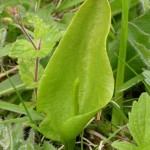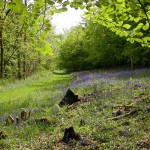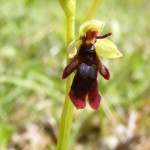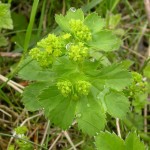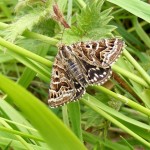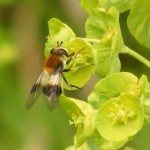Roger Kemp organised a visit on Saturday 25th May to Dancersend near Wendover, a reserve of the Berkshire, Buckinghamshire and Oxfordshire Wildlife Trust (BBOWT). Warden Mick Jones kindly guided members round the reserve. The walk started in woodland at the south-west side of the site. The Bluebells were at their best and a pair of Speckled Wood butterflies were spiralling upwards in the first clearing. Wood Melick, Wood Millet, Yellow Archangel, Woodruff and Sanicle were amongst the sightings in the woods. The path led out into the open Ant Hill clearing. Mick pointed out the leaves of Wood Vetch. The Fly Orchids were in flower and there were a good number of spikes of Greater Butterfly-orchids, which would soon be coming into flower. Also seen were Lady’s-mantle with yellowish-green flowers and Adder’s-tongue Fern, with a shiny yellowish-green leaf and a small central spike. The fenced-off Meadow Plots formed the lower part of the clearing, where Miriam Rothschild pioneered investigations into the best methods of scrub clearance, using at different times estate workers, both light and heavy sheep, goats and cattle. The area has Chiltern Gentians, which benefit from the bare soil created by cattle poaching. A Dingy Skipper butterfly and Burnet Companion and Common White Wave moths were identified in this section.
The walk continued along a valley which had been clear-felled some years ago. Clumps of Stinking Hellebore were growing on the steep sides. When the sun came out, Brimstone and Orange-tip butterflies appeared. The path continued to an area of open grassland. One of the fields, which faces south, still has a rich chalk flora, including the rare Slender Bedstraw. Other plants seen here included Common Milkwort and Salad Burnet. The other fields are being reverted back to chalk grassland from arable land. Scrapes have been carved out to provide steep south-facing banks and sheltered hollows for butterflies. They will be planted up with plugs of Horseshoe and Kidney Vetch. The scrapes have already been colonised by a number of plants, including Blue Pimpernel, Field Madder, Parsley-piert, Round-leaved and Sharp-leaved Fluellen and Mignonette. In conjunction with scientists from the University of Reading, there have been trials for clearing and reseeding sections of the field. Three different speedwells were noted in one of these sections – Germander, Thyme-leaved and Wall. The group then walked back up through the woods to the start. The track passed through a section with big trees but no Bluebells on the right, an area of secondary woodland, which contrasted with an ancient woodland section on the left, with carpets of Bluebells, Hazel Coppice and a much richer variety of trees and bushes in the under-storey.
After a picnic lunch, the group drove round to the Crong Meadow, next to the Waterworks at the south-east side of the reserve. There were Green-veined White and Orange-tip butterflies, a Green Carpet, a Mother Shipton and Common Carpet moths and a number of unidentified spiders. A striking hoverfly which was visiting the flowers of Wood Sage was identified as Leucozona lucorum. It had chestnut on the thorax, a dark abdomen with a bold broad white band and dark wing markings. The hooting call of a Tawny Owl coming from the surrounding woods was a surprise for broad daylight.
Pictures by Rob Stallard and Jan Haseler

